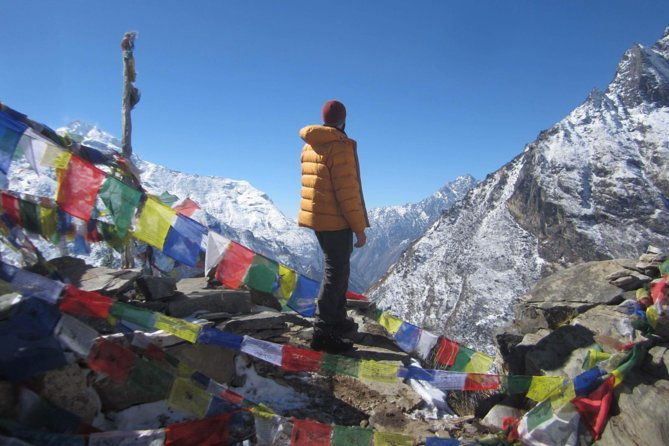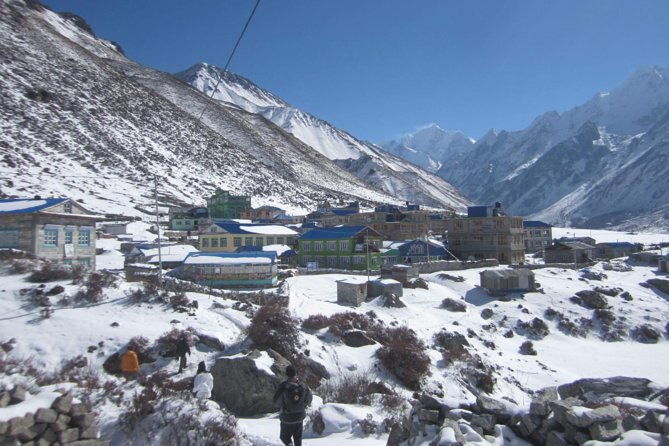Travelers seeking a mountain adventure close to Kathmandu will find this 7-day Langtang Valley trek to be a balanced mix of natural beauty, local culture, and manageable trekking distances. Known as “The valley of glaciers,” Langtang offers an authentic Himalayan experience without the intensity of longer routes. It’s perfect for those who want to soak in stunning vistas, explore Tibetan-influenced villages, and enjoy diverse flora and fauna in just a week.
What makes this trek stand out? We love the expert guidance from experienced local guides, the spectacular mountain panoramas including Langtang Lirung, the chance to walk through bamboo forests and meadows, and the value for money at just $585, including accommodations and permits. A potential downside? The trek involves several long walking days, so a reasonable level of fitness is a must. This trip suits adventurous travelers who appreciate cultural encounters and natural beauty without the challenge of high-altitude extremes.
Key Points

- Accessible Himalayan experience within 7 days from Kathmandu
- Diverse landscapes including forests, glaciers, and alpine meadows
- Cultural immersion in Tibetan villages
- Great value with all essential permits, meals, and guides included
- Expert local guides with positive reviews for knowledge and friendliness
- Moderate physical fitness needed for some long trekking days
An Authentic Himalayan Journey Close to Kathmandu
This 7-day Langtang Valley trek is an excellent option for travelers who want to experience the Himalayas without committing to a longer, more strenuous expedition. The trek’s proximity to Kathmandu means you can start your adventure with a scenic drive, duration being around 7-8 hours, from bustling city streets to tranquil mountain villages. The route winds through lush forests, traditional Tibetan villages, and sweeping mountain vistas, making every step worthwhile.
What makes Langtang special? It’s the combination of natural splendor and cultural depth. You’ll pass through rhododendron and bamboo forests, spot waterfalls, and see wildlife like monkeys, Himalayan black bears, and even rare red pandas. The trails lead you past glacial streams, snowy ridges, and high passes, with the imposing Langtang Lirung (7246m) looming above. The area’s designation as Nepal’s first Himalayan national park in 1971 underscores its ecological significance.
Here are more experiences we've reviewed in Kathmandu
The Itinerary: A Day-by-Day Breakdown

The journey starts with your transfer from Kathmandu to Syabru Bensi, an approximately 7-8 hour drive through scenic countryside. This allows you to shake off city fatigue and gear up for the trek ahead.
Day 3: You’ll begin walking from Syabru Bensi to Lama Hotel, a route of about 6-7 hours and roughly 1070 meters of ascent. The trail is dotted with local villages, bamboo groves, and mountain streams. The Lama Hotel is a basic yet comfortable resting spot, where many reviewers mention the friendly staff and simple amenities.
Day 4: Continuing to Langtang Village (about 7-8 hours), you’ll trek through denser forests and charming hamlets. Langtang Village offers a taste of local Tibetan-influenced culture, with gompas and traditional houses. Reviewers highlight the warmth of the locals and the scenic beauty, noting it’s a highlight of the route.
Day 5: A shorter trek of 2-3 hours takes you to Kyanjin Gompa, at 3870 meters. Here, the views of snowy peaks are breathtaking, and many travelers find this to be the trek’s standout moment. If time allows, hikers often visit Kyanjing Ri for a panoramic overlook, adding another rewarding climb.
Day 6: The return journey is long but rewarding, trekking back down to Lama Hotel (about 7-8 hours). It’s a chance to appreciate the landscape from a different perspective, and many comment on the surprisingly smooth descent and the stunning scenery along the way.
Day 7: Completing the loop with a trek to Syabru Bensi, then a drive back to Kathmandu, totals around 7-8 hours. The drive offers one last look at the mountains and local life, rounding off your adventure.
What’s Included and What’s Not
The package provides excellent value: three meals daily (breakfast, lunch, dinner), basic teahouse accommodations, all necessary permits (Langtang National Park permit and TIMS card), and professional guides. The guides are frequently praised for their knowledge and friendliness—many reviewers mention guides like Rupak and Badri as making the trip memorable.
Accommodation is in simple tea houses on twin-sharing basis, with outdoor toilets, which is typical for this kind of trek. In Kathmandu, you’ll stay in a deluxe hotel, adding comfort after your days on the trail.
The tour covers all transportation costs from Kathmandu to Syabru Bensi and back, as well as airport transfers. Emergency services are included, but travelers are advised to have comprehensive travel insurance covering helicopter evacuations and medication.
Extras not included are beverages, personal expenses, tips, extra nights in Kathmandu, international flights, and travel insurance, so budget accordingly.
The Experience: What You’ll Realistically Encounter
Expect to walk 6-8 hours daily on uneven, sometimes steep terrain. The trail is suitable for those with moderate physical fitness and some trekking experience, as several days involve significant elevation gain and descent.
Many reviewers mention the guides’ expertise—from advising on packing to navigating tricky sections—and their local knowledge about wildlife and culture. For instance, one traveler notes their guide, Rupak, was outstanding, providing not just navigation but insights into local Tibetan traditions.
Scenery wise, you’ll be captivated by the changing landscape: from lush forests with blossoming rhododendrons in spring to snow-capped peaks and glacial streams. Waterfalls and mountain vistas constantly surprise you, and wildlife sightings, although rare, include monkeys and sometimes wild boar.
Cuisine: Meals are hearty and consistent, with many reviewers praising the food in teahouses. Expect simple yet flavorful local dishes like dal bhat and momo, which keep you energized for each day’s hike.
Guides and Service: Highly Praised for Knowledge and Friendliness
From reviews, guides like Rupak and Badri are highlighted as knowledgeable, friendly, and attentive, often going above and beyond to ensure travelers are comfortable and informed. Many travelers note that their guides offered helpful advice about altitude, packing, and local customs, making the experience both safe and culturally immersive.
The group size is typically small, so personalized attention is common, which many travelers appreciate. The guides’ ability to provide a good mix of professionalism, humor, and local insight significantly enhances the overall trek.
Prefer keeping things personal? Here are more private experiences we've reviewed in Kathmandu
- Kathmandu: Private Sightseeing Tour
- Kathmandu: Private/Group 4 UNESCO World Heritage With Lunch
- Kathmandu: 7 UNESCO Sites Private or Group Tour With Lunch
- Kathmandu: Private/Group Tour to 7 UNESCO Sites With Lunch
- Kathmandu: Nagarkot Sunrise Tour Private or Group With Lunch
- Kathmandu: 7 UNESCO Sites Private With Dinner/Group Day Tour
Practical Tips for a Smooth Trek
- Physical Fitness: The trek requires moderate fitness and comfortable walking shoes. Some days are longer, and altitude gains can be demanding, so prepare accordingly.
- Packing: Essential gear includes a sleeping bag, down jacket, trekking poles, and raincoat. You can rent or buy gear in Kathmandu if needed.
- Altitude Awareness: The highest point, Kyanjin Gompa at 3870 meters, is manageable for most, but those with altitude sensitivity should take precautions.
- Weather: The trek operates in all weather conditions, so pack layers and be prepared for rain, wind, or sun.
- Travel Insurance: Strongly recommended, especially with helicopter evacuation coverage, as the trek includes remote areas.
Who Is This Trek Perfect For?
This trek is ideal for those seeking a shorter Himalayan adventure without high-altitude risks. It’s excellent for cultural enthusiasts, wanting to experience Tibetan-influenced villages, as well as nature lovers eager to explore forests, glaciers, and mountain peaks.
If you’re comfortable with long walking days and are looking for value—including permits, guides, and meals—it’s a smart choice. The trek’s moderate difficulty makes it accessible for travelers with some trekking experience but not necessarily seasoned mountaineers.
Final Thoughts: Why You Should Consider the Langtang Valley Trek
This 7-day guided trek offers a well-rounded Himalayan experience in a manageable timeframe. With stunning scenery, friendly local cultures, and expert guides, it delivers excellent value for your money. The trek’s relaxed pace means you can soak in the mountain views and cultural richness without feeling rushed.
It’s perfect for first-time trekkers looking for a taste of Nepal’s natural beauty, adventurers wanting a shorter but still rewarding mountain trip, or those with limited time who want a genuine Himalayan experience close to Kathmandu.
If you want to balance scenic beauty, culture, and comfort, this trek ticks all the boxes while keeping it affordable and accessible. Prepare for a journey filled with breathtaking views, authentic village life, and memories that will last a lifetime.
Frequently Asked Questions
How long is the drive from Kathmandu to Syabru Bensi?
It’s about a 7-8 hour scenic drive, providing a good introduction to the landscape before you start trekking.
What type of accommodation is included?
You’ll stay in basic tea houses on twin-sharing basis, with outside toilets, typical for Himalayan trekking routes.
Are meals provided during the trek?
Yes, three meals a day—breakfast, lunch, and dinner—are included, with local dishes that are hearty and flavorful.
What permits are included in the tour?
The package covers the Langtang National Park permit and a TIMS card necessary for trekking in Nepal.
Is the trek suitable for children?
Children must be accompanied by an adult and should have a moderate fitness level. The trek involves some long walking days.
Who guides the trek?
Experienced English-speaking guides, often praised for their friendliness and knowledge, lead the group.
What should I pack?
Essential gear includes a sleeping bag, down jacket, trekking poles, raincoat, sunglasses, thermal clothing, and personal essentials.
Can I customize the itinerary?
Yes, the tour provider can tailor the trip based on your interests and preferences.
Is travel insurance necessary?
Highly recommended, especially to cover emergency evacuation and medical treatment.
What is the best time of year to do this trek?
While operating in all weather conditions, many prefer spring (March-May) and autumn (September-November) for optimal scenery and weather.
This detailed look at the 7 days Langtang Valley trek underscores its appeal as a manageable, memorable Himalayan journey. From stunning mountain vistas and vibrant Tibetan culture to expert guides and excellent value, it’s an adventure worth considering for your Nepal trip.
More Hiking & Trekking Tours in Kathmandu
More Tour Reviews in Kathmandu
Still browsing? Here are more Kathmandu experiences we've covered recently
- Gokyo Lakes And Renjola Pass Trek – 12 Days
- Walking Local Street Food Tour in Kathmandu
- Annapurna Circuit Trek
- Spirit of Nepal – 10 Days Tour
- Kathmandu: Nagarkot Sunrise & Hike to Changu Narayan Day Tour
- Annapurna Circuit Short Trek
- Kathmandu: Pharping Monastery & Asura Cave Meditation Tour
- Everest Base Camp trek- 13 Days
- Annapurna Base Camp Trek- 12 Days
- Everest Panorama Helicopter Tour
- Nagarkot day trip
- Annapurna Base Camp Trekking 09 Days
